

Competency DEVELOPMENT GUIDES. Introduction to Competencies. Competencies are probably most closely related to abilities.
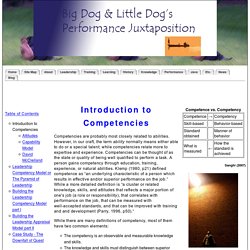
However, in our craft, the term ability normally means either able to do or a special talent; while competencies relate more to expertise and experience. Competencies can be thought of as the state or quality of being well qualified to perform a task. A person gains competency through education, training, experience, or natural abilities. Klemp (1980, p21) defined competence as “an underlying characteristic of a person which results in effective and/or superior performance on the job.” While a more detailed definition is “a cluster or related knowledge, skills, and attitudes that reflects a major portion of one's job (a role or responsibility), that correlates with performance on the job, that can be measured with well-accepted standards, and that can be improved with training and and development (Parry, 1996, p50) While there are many definitions of competency, most of them have two common elements: David McClelland.
Definition of Competency. What is Competency-based Career Planning & Development? Part 3 of 11 of the CompetencyCoreTM Guide to Career Planning & Development Career Development Defined Career DevelopmentCompetency-based Career Development is a planned system to link individual career needs with the organization’s workforce requirements.

From the employee perspective, they are looking for career opportunities that address their strengths, support development, provide challenges and match personal interests, values and preferred working styles. The organization on the other hand is looking to have employees develop themselves in a way the addresses the organizational needs. Therefore, putting career development tools and processes in place to highlight the options and career paths available to employees is in both the organization’s as well as the employee’s best interests.
Competency Architecture. 'The Big 8' Skills Give Lift to Rare-Air Executives. Building the Leadership Skills that Matter. Learning Agility - A 2020 Leadership Competency. During an A.J.
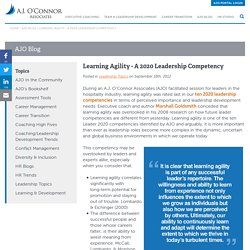
O'Connor Associates (AJO) facilitated session for leaders in the hospitality industry, learning agility was rated last in our ten 2020 leadership competencies in terms of perceived importance and leadership development needs. 10 Essential Skills for The 21st Century Worker/ Learner. A Very Good Checklist for Assessing 21st Century Learning Skills. January 29, 2015 Here is another great resource from Dr.
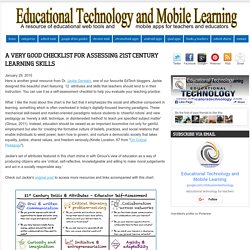
Jackie Gerstein, one of our favourite EdTech bloggers. 21st Century Skills. Systems-Oriented Leadership Competencies. Developing Leadership Character. Using Competencies to Create Leadership Brand. Return on Leadership: Competencies that Generate Growth. Leadership Competencies. Fast Fact The SHRM special expertise panels recently identified top workplace trends for 2007-2008.
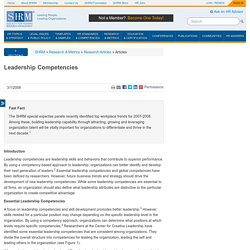
Among these, building leadership capability through attracting, growing and leveraging organization talent will be vitally important for organizations to differentiate and thrive in the next decade.1 Introduction. Leadership competence. The DEFINITIVE Leadership Competencies Guide. Lominger Competencies. Harvard University Competency Dictionary. Performance Partnership Competency Library. A guide for identifying and discussing performance behaviors for successful job performance.

Table of Contents The primary purpose of this library is to help all staff members (supervisors and non-supervisors) to define important workplace behaviors. In this sense, this library is really a dictionary and guide. The library offers a common vocabulary all staff members can use to talk about behavioral skills. PDI competencies. Military Strategic Leadership Competencies and Skills.
Army Leadership-Core Leader Competencies. Building a Competency Model. Korn Ferry Leadership Architect™ Global Competency Framework. Attracting and building the right talent is imperative for long-term organizational success.
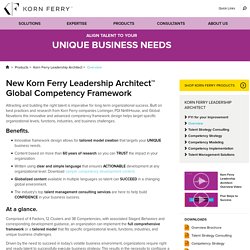
Built on best practices and research from Korn Ferry companies Lominger, PDI NinthHouse, and Global Novations this innovative and advanced competency framework design helps target specific organizational levels, functions, industries, and business challenges. Benefits. Innovative framework design allows for tailored model creation that targets your UNIQUE business needs.Content based on more than 60 years of research so you can TRUST the impact in your organization.Written using clear and simple language that ensures ACTIONABLE development at any organizational level. Download sample competency development content.Globalized content available in multiple languages so talent can SUCCEED in a changing global environment.The industry's top talent management consulting services are here to help build CONFIDENCE in your business success. At a glance. Five steps to success. Developing a Competency Framework - Learning Skills from MindTools.com.
Linking Company Objectives and Personal Performance © VeerBinkski Objectives should align across the oganization.

You're probably familiar with the phrase ‘what gets measured gets done.' Defining and measuring effectiveness – especially the performance of workers – is a critical part of your job as a manager. The question is: How do you define the skills, behaviors, and attitudes that workers need to perform their roles effectively? Some people think formal education is a reliable measure. All of these are important, but none seems sufficient to describe an ideal set of behaviors and traits needed for any particular role.
A more complete way of approaching this is to link individual performance to the goals of the business. What is a leadership competency & how to create a competency model. Nonprofit Leadership Development Guide - Bridgespan. The Skills Leaders Need at Every Level. A few weeks ago, we were asked to analyze a competency model for leadership development that a client had created.

It was based on the idea that at different points in their development, potential leaders need to focus on excelling at different skills. For example, in their model they proposed that a lower-level manager should focus on driving for results while top executives should focus on developing a strategic perspective. Intuitively, this makes sense, based as it is on the assumption that once people develop a skill, they will continue to exercise it. But, interestingly, we don’t apply it in athletics; athletes continue to practice and develop the same skills throughout their careers. And as we thought about the excellent senior executives we have met, we observed that they are, in fact, all very focused on delivering results, and many of the best lower level managers are absolutely clear about strategy and vision. The Top 10 Leadership Competencies. Five Leadership Competencies. The Four Most Desirable Leadership Competencies.
In over 60 searches for top executives, we’ve been asked to look for the same core competencies again and again; relationship building, strategic thinking, and communication.

Other requirements change from search to search, but these four competencies are so consistent that they seem to be almost universal. Whether you’re looking to hone your own leadership skills or starting out an executive search, these competencies are a good place to start. 1) Integrity Integrity permeates every aspect of a leader’s universe – every decision, relationship and action should be guided by ethics and company values. Integrity builds trust both within organizations and with the people they serve. It also facilitates timely and effective decision-making. Ethical behavior and graceful management of tough situations are what sets leaders apart, allowing them to earn the trust of their employees and credibility within the field.
Beware: missteps in this area are often disastrous. 2) Relationship Building. Leadership Competencies. Leadership Competencies and Behavioral Descriptors. Proficiency Levels for Leadership Competencies.